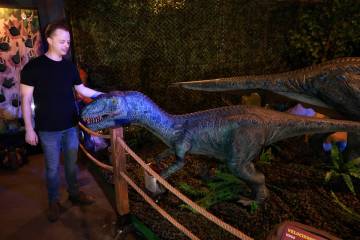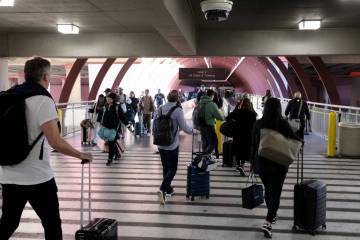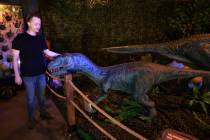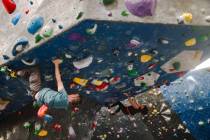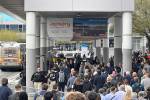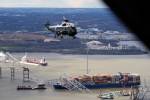Reporter battles heights, nature at Grand Canyon Skywalk
Glass -- an 1,800-pound sheet of it -- is about to tumble out of the night sky above my head, like a bad special effect from the original "Superman" movies.
Today, I'm the seventh member of Kingman, Ariz.'s Highland Glass, the crew replacing the 2½-inch-thick transparent bottom of the Grand Canyon Skywalk. Jutting 70 feet off the canyon's west rim near Peach Springs, Ariz., this horseshoe-shaped overlook -- or, more accurately, underlook -- is one of the most popular day-trip destinations for Las Vegas tourists.
Four years after opening day, however, the Skywalk glass was starting to look as cloudy as the future of my profession. Some protection was provided by requiring all 1.4 million visitors to slip paper booties over their footwear. But dust grains ground in by the booties still left tiny scratches. Of the 46 panes that needed replacing, only five remain in this $1.6 million job, which is performed at night to keep the Skywalk open by day.
"Everything in the glass business is very heavy and very dangerous," warns Highland Glass owner Micah Jones.
I venture out to inspect the pane I will help replace, which is midway up the horseshoe's right arm. Having already washed the Stratosphere's windows, changed the lights on the Fremont Street Experience canopy and operated a crane atop the Trump International Hotel, I can't call walking the Skywalk that terrifying an ordeal (although the view is killer). However, the day's final tourist, San Francisco resident Lev Ryzhikov, is doing an impression of Wile E. Coyote just after stepping off a cliff and remembering his obedience to gravity.
Facing his fear of heights here was the idea of Ryzhikov's friend, Valentina Yasinsky, who completed the walk 10 minutes ago and cheers him on from the visitor center.
"It's not working," Ryzhikov calls out to Yasinsky, as he manages only four inches of forward motion per two-handed tug on the railing.
I tell Ryzhikov not to worry, because we'll be replacing the pane that has the giant crack in it before anyone falls through. (Yasinsky explains that I'm only joking.)
The joke will be on me once the old pane is removed via a 200-foot crane equipped with pressurized suction cups. At that point, nothing will separate me from a 4,000-foot kerplop besides a harness connected to the Skywalk's steel frame. And Jones has already strapped that on me backward. ("Oops, sorry," he says after another worker corrects the mistake.)
And you thought Jetman made a popular YouTube video at the Grand Canyon?
Closing time for the Skywalk, 7 p.m., means starting time for the glass techs, who normally work until 4 a.m. My first duty is to rub serum oxide, which dissolves impurities, onto a sheet of the Skywalk's new half-inch-wide surface layer. Only this layer will need replacing when scratches appear again. (You live, you learn, you avoid spending $1.6 million more than once.)
Next, I remove some of the metal plates and rubber insulation locking the old panes in place. (Their sheer weight holds them down for now.)
Even when potential falls to your death don't factor in, a number of things can ruin your day when you're installing huge plates of glass. Four years ago, Jones watched one of his employees lop off his right hand during a shopping center project.
"He wasn't paying attention," Jones says matter-of-factly. (The hand was successfully reattached.)
Tonight, if a pane clinks the sides of the Skywalk's frame hard enough, the results will probably include hundreds of thousands of dollars in damages and much worse: a huge "I told you so" from my mom for not going to law school like she wanted me to.
Oh, and I haven't even told you the craziest part: Our crane is positioned behind the visitor center, so its operator can't even see where he is lowering the glass. (Instructions are provided by a signaler with a walkie-talkie.)
Before any glass flies, though, one minor task remains. Four years ago, a net was installed to catch any stray plummeting objects and workers during construction of the visitor center. Since it already has the crane here, Executive Construction Management of Las Vegas has decided to use it -- along with the glass crew -- to remove the obsolete safety feature.
Jones invites me to help. He motions for me to join two of his employees in a 5-by-5-foot passenger hoist suspended over the net.
I decline, reminding Jones that my story is about laying glass. In truth, I'm laying my own personal bricks. For a million dollars, I might consider dangling three quarters of a mile above the ground by a wire -- controlled by a man who can't see me -- as we cut down the only thing that can save us if something goes horribly wrong.
But wages in this job start at $25 to $45 per hour, capping at about $55,000 per year once you join the local glassworkers union.
Anyway, there are already too many people suing over the Skywalk for my survivors to be added to the list. The Hualapai tribe (which owns the land and charges $43 for visitors to enter it) is currently battling Grand Canyon Skywalk Development (which owns the $100 million attraction and charges another $32) in federal court over revenue and ownership.
"OK, don't say I didn't give you the chance," Jones says. (OK, I won't.)
An hour is allotted for net removal. But for every connection severed between the net and the Skywalk by power saws and welding guns, three more hidden ones reveal themselves. (The net was installed by some long-gone subcontractor.)
One hour becomes five. But that's OK. I'm here as long as the job takes.
"Uh-oh," Jones says as he extends an arm.
It's an updraft. A north wind banks upward off the cliff below us. For two of the four weeks originally scheduled to complete this project, wind has forced delays. But none was forecast for this evening.
"Not good," Jones says.
The gusts scrape the hoist against the sides of the Skywalk. Breath is held, whimpers ensue. Fortunately, I am able to compose myself.
That's when the true horror of this situation takes hold. Videographer Michael Quine and I have been on site for five hours. Before that, we drove three hours from Las Vegas. (It's supposed to take two, but I recommend some vehicle other than a Toyota Camry that once belonged to your parents. A lunar rover might be a better match for 14 treacherously unpaved miles of Diamond Bar Road. Or a tank, if you don't want to total your ride in a possible collision with one of hundreds of the world's free-est ranging cattle.)
To endure all that, and then return without a story, would suck in ways that haven't been invented yet. (By the way, the drive ahead of us is the same except in pitch blackness.)
"Don't worry," Jones says. "We're flying glass tonight."
The wind has other plans. It swells to 30 mph straight upward. The net dances so wildly that, just before it is finally detached, it breaks a glass tech's thumb. Falling off the Skywalk now could result in merely hovering in place.
The crew hightails it to the area beneath the crane, where the net is folded and discarded. A meeting convenes with the crane operator, who shakes his head repeatedly.
"I'm sorry, man," Jones tells me. "I feel really bad."
He adds: "So, you coming back tomorrow to get your story?"
See video of Levitan doing nothing at the Skywalk at www.lvrj.com/skywalker. Fear and Loafing runs the first Sunday of every month in the Living section. Levitan's previous columns are posted at www.lvrj.com/corey and www.fearandloafing.com. If you have a Fear and Loafing idea, call (702) 383-0456 or email clevitan@ reviewjournal.com.




